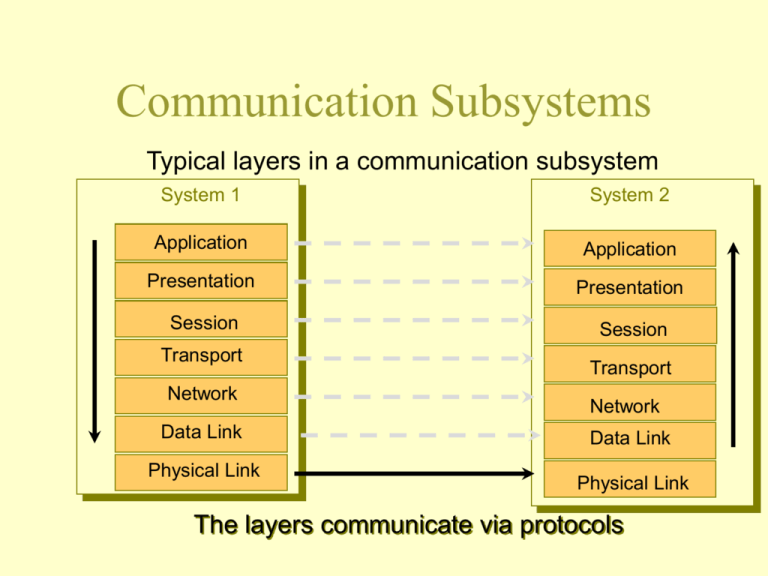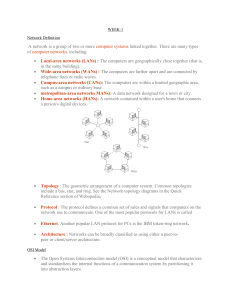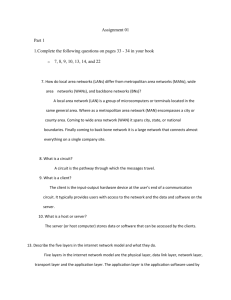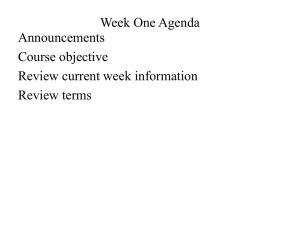Network Communication
advertisement

Communication Subsystems Typical layers in a communication subsystem System 1 System 2 Application Application Presentation Presentation Session Session Transport Network Data Link Physical Link Transport Network Data Link Physical Link The layers communicate via protocols Communication Subsystems Typical layers in a communication subsystem System 1 System 2 Application Application Presentation Presentation Session Session Transport Network Data Link Physical Link Virtual communication Transport Network Data Link Physical Link The layers communicate via protocols Communication Subsystems Typical layers in a communication subsystem System 1 System 2 Application Application WSFTP,Netscape Presentation Session Transport Network Data Link Physical Link FTP, HTTP Sockets TCP,SPX IP,IPX Ethernet Wire Presentation Session Transport Network Data Link Physical Link The layers communicate via protocols Fitting it together Application Program Data Socket Definition Data TCP Header Data IP Header Data Ethernet Header Data Check Application • The program that the user interfaces with to gain access to the network • Internet Explorer, Outlook, WSFTP, SSH all provide the keystroke reception and display presentation to the user in a human readable format. Presentation • Takes data to/from the Application and provides a protocol for formatting the data in a method unique to the application. • HTTP (HyperText Transfer Protocol), handles commands for interfacing with the servers of the World Wide Web. • FTP (File Transfer Protocol), handles commands for listing, sending, and receiving files. Session • The session layer decodes socket information from the packet and dispatches the program that will process the protocol that the socket defines. Transport • The transport layer determines which transport protocol is being sent to the upper layers. TCP (Transmission Control Protocol), ICMP (Internet Control Messaging Protocol), SPX (Service Packet Exchange), or UDP (User Datagram Protocol). Network • The network layer handles the internet protocols, decodes the proper address (internet or IPX), decodes the transport type, and the time to live values. Data Link • This layer is the protocol used on the wire such as, ethernet, token ring, Point to Point Protocol (PPP, dialup), DSL, broadband and so on. • This layer has low level addressing and frame checking. Directing Packets • At this the lower levels of the OSI model, drivers can either packet forward or packet filter the frames being processed. • If the packet is of the proper type and address it will be forwarded up the stack. • If the packet is not of the proper type, identification, or address it will be ignored by the upper layers of the model. • Packet forwarding and filtering allow lower levels of the model to take the load off of the higher levels by ignoring packets not needed. The filtering process also adds to system security by ignoring services we don’t want to handle on a particular system. OSI layer mnemonics • • • • • • • All People Seem To Need Data Processing Away Pizza Sausage Throw Not Do Please Application Presentation Session Transport Network Data Link Physical OSI Layers and Operating Systems • Windows NT – File System Drivers (application, presentation, and session layers) – Transport Protocols (transport and network) – Network interface card drivers (datalink and physical) NT Interfaces • Application Programming Interfaces ort APIs, allow programmers to access network services. • Transport Driver Interfaces or TDIs are between the transport and the API levels. • Network Driver Interface Specifications or NDISs communicate from the NIC to the TDI. IEEE Ethernet Frame Categories • 802.3 – Novell’s Ethernet (handled IPX, limited use) • 802.3 (Ethernet II) – Based on 802.3 – Most commonly used today – Type byte instead of Total Packet length • 802.5 – Token ring definition • Ethernet 802.11 – Wireless definition – 900mhz, 2.4 ghz, 5.7 ghz OSI Model Enhancements (Data Link Layer) • Logical Link Control (LLC) – Control links, frame traffic, sequencing, and frame acknowledgment – Uses logical service access points (SAP) to transfer information up the OSI layers • Media Access Control (MAC) – Handles media (wire) access, frame start/end, frame error check, and frame addresses. Drivers and the OSI Model Network Software Driver Network Interface Card Network Driver Interface Specification (NDIS) • Sets rules for driver interfaces from the MAC (media access control) sublayer and the protocol drivers. • Protocol Stack – Frame assembler and disassembler • Adapter Driver – To/from NIC and protocol stack • Protocol Manager – Controls traffic from protocol stack to the MAC Open Data-Link Interface (ODI) • • • • Novell and Apple specification Supports multiple protocols Incompatible with NDIS Driver compatibility can be handled through translator programs. Review Transmission Lines Full Duplex Half Duplex Resistance (Loss) Capacitance/Inductance (waveform modification) Timing problems Star and Bus topologies Broadband vs. Baseband netorks Security: Party Line, Physical access Network Operating systems, Microsoft, Novell, Apple Client/Server vs. Peer to Peer systems More Review Ethernet addresses, uniqueness Physical Layer (Network Model), ethernet Ethernet, coax, twisted pair, fiber Transmit and receive on different pairs of wire Crosstalk Cable Lengths, rules Token ring Hubs, Repeaters, Bridges, and Switches 3-4-5 rule for 10mb Network diameter rule for 100mb 10baseT jacks, cables, connectors 100baseT rules Network layers, IEEE 802 categories, drivers





